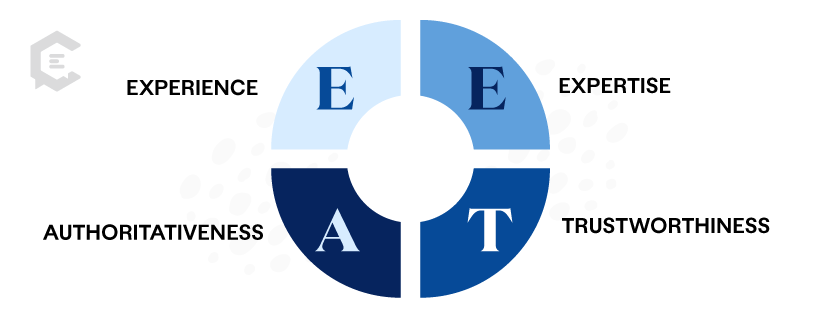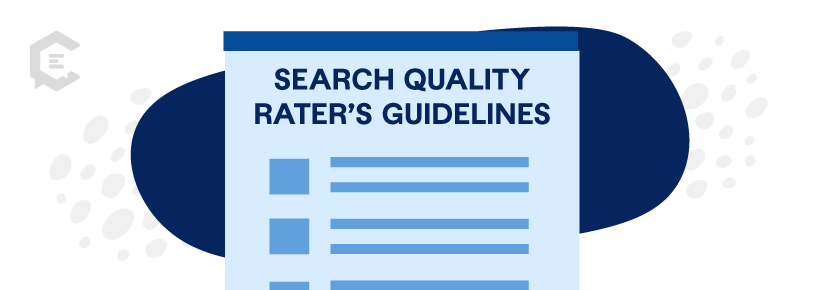What is Google’s E-E-A-T Guideline?
Google’s EEAT guideline (formerly E-A-T guideline) refers to the factors of Experience, Expertise, Authoritativeness, and Trustworthiness that Google considers when evaluating the quality and relevance of web content. These individual aspects are separately assessed by human quality raters based on several factors.

Experience
Quality content should go beyond theoretical knowledge. To fulfill this factor, the creator must demonstrate first-hand experience with the subject matter. The content reflects practical insights from personal involvement, experimentation, or real-world application. By showcasing their expertise, content creators can provide evidence that their suggestions, recommendations, or advice have been tried, tested, and proven effective.
Expertise
When evaluating page quality, raters look at the expertise and credibility of the content’s creator. Expertise indicates that you can produce original, reliable, and factual information based on various sources, like education and years of practice.
Varying degrees of expertise need to be proven based on your niche. For example, if you blog about medicine, you must have medical expertise and verifiable accreditations. But if you only blog about beauty, fashion, or a specific hobby, your “everyday expertise” will be considered by quality raters even without proof of any formal training or education.
Authoritativeness
Google’s search quality raters validate authoritativeness based on accessible information about the content creator’s reputation. Reviews, testimonials, mentions, news articles, interviews — anything indicative of a positive reputation can work in your favor as far as E-E-A-T is concerned.
It’s worth mentioning that authoritativeness in one industry isn’t transferable to another. You can be widely considered an authoritative, go-to source for money-related content. But you can’t leverage that authority to establish E-E-A-T in food, fitness, and other unrelated topics.
Trustworthiness
Trustworthiness is all about transparency and the factual accuracy of your content. According to Google’s Search Quality Rater’s Guidelines, being “transparent” includes having adequate contact details and customer support information for certain businesses. Regarding content, pieces must contain accurate information with proper citations to other trustworthy sources.
Why is E-E-A-T important?
Although Google algorithm updates are unpredictable, the entire SEO community can be sure of one thing: search engines always implement changes based on what will benefit their users.
Whether it’s about urgent matters or just conversational search queries doesn’t matter. To be visible in search engines, you need to prove some degree of expertise, authoritativeness, and trustworthiness. If you confirm that you’re an authoritative and trustworthy expert in your field, it will be easier to convince your audience to believe in your value proposition and convert them into paying customers.
E-E-A-T is looked at more rigorously in YMYL (Your Money or Your Life) niches, which are industries that affect a person’s health, finances, and security. This applies to websites that discuss any of the following topics:
- Finance
- Shopping
- Culture and groups of people
- News and current events
- Politics
- Healthy, safety, and security
Optimizing for E-E-A-T is paramount to SEO success if your brand falls under the YMYL industry.
What is the Google quality rater’s guide?
E-E-A-T came from Google’s Search Quality Rater’s Guidelines. It is an in-depth guide designed to help human raters assess search results’ page quality and determine the effectiveness of tweaks to search engine algorithms. Here’s how Google uses these guidelines:
- Step 1: Google’s search engineers develop new algorithm updates that could improve the quality of search engine results. These changes usually cause drastic changes in a lot of websites’ rankings.
- Step 2: Quality Raters are presented with the search engine results before and after the changes. Using the Search Quality Rater’s Guidelines, they provide feedback on the quality of search results and send their findings back to Google.
- Step 3: If the change affects overall search quality positively, it will be implemented in Google’s live version. Otherwise, the proposed change is scrapped, and the search engine algorithm remains untouched.
Learning the Search Quality Rater’s Guide gives you an insider’s look at what Google defines as “rank-worthy” content.
Google EEAT guidelines for content marketers
Here’s a quick E-E-A-T SEO checklist you can use to help your website rise in search results:
Double down on link building
Link building and guest blogging benefit two out of three components of E-E-A-T outright, particularly when targeting high-authority websites. Authoring a few posts on other websites will improve your expertise and authority. The same can be said whenever your brand gets mentioned by other well-known blogs in your space.
Always link to trustworthy references
Linking to references, especially when citing data, makes your content more trustworthy. The Search Quality Rater’s Guidelines repeatedly expressed that high-quality pages back up claims with links to reputable sources. At the same time, pages that fail to cite sources are considered low-quality.
Build more high-quality content
In addition to E-E-A-T, Google’s Search Quality Rater’s Guidelines also specifies the amount of high-quality MC (Main Content) as an important factor in page quality ratings.
Showcase your expertise
There are several ways to show expertise when producing web content. One example is including author boxes highlighting the writer’s expertise and professional background. It’s also important to have tidbits of unique information the expert pulled from experience — not from another online source that can be easily traced.
Include your contact information
Include your contact information on your website — on author bio boxes and page footers. This adds to your trustworthiness and credibility. You can also design a dedicated “Contact” page with multiple options, so your site visitors have several ways to connect with you.
Additional tips for Google EEAT
- For YMYL sites, be sure to regularly remove outdated stats and update them with links to newer sources
- Consider hiring certified experts to produce content for you
- Make customer reviews and testimonials a part of your long-term content strategy
Start creating content that oozes E-E-A-T
Google EEAT may involve aspects beyond just content writing, but it is absolutely essential.
Building an authority-driven content marketing strategy is essential to establishing your expertise, credibility, and trustworthiness. ClearVoice can help with its global network of experts with certifiable expertise on a wide range of topics. They’re ready to provide E-E-A-T-ready content, even for YMYL topics like medical science and personal finance.





